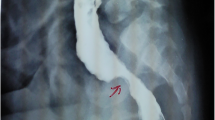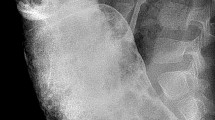Abstract
Purpose
Presence of transition zone (TZ) in the pulled colon can impact the outcome of surgery in children with Hirschsprung’s disease. There is a wide variation in terminology used to define TZ and its management. We present our series of managing 11 such children with considerations for conservative management.
Methods
Eleven of 114 children operated for Hirschsprung’s disease had features of TZ on the 4-quadrant doughnut assessment of proximal anastomosing margin. They were followed up for development of obstructive symptoms, failure of pull-through procedure or bowel-related complications. Intervention done were observation with laxatives, dilatation, Botox injection and redo pull-through.
Results
Of the 11 children, 6 underwent Duhamel’s procedure and 5, transanal endorectal pull-through (TERP). Features identified on HPE were presence of hypertrophic nerve bundles involving 2 or 3 quadrants in the circumferential doughnut biopsy of proximal anastomosing margin. Observed symptoms included constipation, enterocolitis, increased bowel frequency and soiling. Intervention done were use of laxatives with bowel management program in six and Botox injections in four. Only one child with TZ in 3 quadrants required redo surgery. Mean follow-up was 5.2 years with resolution of symptoms in most.
Conclusion
This study highlights the role of conservative management with good outcomes in children with TZ bowel pull-through having hypertrophic nerve fibers and normal ganglion pattern. Children who underwent Duhamel’s procedure had little impact with the presence of TZ at anastomotic margin and majority of those undergoing TERP benefitted from Botox injection. Conservative management can be attempted successfully to prevent redo surgical interventions as they can lead to poorer outcomes. Only those children not responding to conservative measures need to be planned for revision surgery.


Similar content being viewed by others
References
Holschneider AM, Puri P (2008) HSCR and allied disorders, 3rd edn. Springer Verlag, Heidelberg
Kapur RP, Kennedy AJ (2012) Transitional zone pull through: surgical pathology consider- ations. Semin Pediatr Surg 21(4):291–301
Swenson O, Bill AH Jr (1948) Resection of the rectum and rectosigmoid with preservation of the sphincter for benign spastic lesions producing megacolons: an experimental study. Surgery 24:212–220
White FV, Langer JC (2000) Circumferential distribution of ganglion cells in the transition zone of children with Hirschsprung disease. Pediatr Dev Pathol 3:216–222
Ghose SI, Squire BR, Stringer MD et al (2000) HSCR: Problems with transition-zone pull-through. J Pediatr Surg 35:1805–1809
Boman F, Sfeir R, Priso R et al (2007) Advantages of intraoperative semi- quantitative evaluation of myenteric nervous plexuses in patients with Hirschsprung disease. J Pediatr Surg 42:1089–1094
Coe A, Collins MH, Lawal T et al (2012) Reoperation for Hirschsprung disease: pathology of the resected problematic distal pull-through. Pediatr Dev Pathol 15:30–35
Lawal TA, Chatoorgoon K, Collins MH et al (2011) Redo pull-through in Hirschprung’s [corrected] disease for obstructive symptoms due to residual aganglionosis and transition zone bowel. J Pediatr Surg 46:342–347
Ghosh DN, Liu Y, Cass DT, Soundappan SSV (2017) Transition zone pull-through in Hirschsprung’s disease: a tertiary hospital experience. ANZ J Surg 87(10):780–783
Menezes M, Corbally M, Puri P (2006) Long term results of bowel function after treatment for HSCR: a 29-year review. Pediatr Surg Int 22:987–990
Teitelbaum DH, Coran AG (2003) Reoperative surgery for Hirschsprung’s disease. Semin Pediatr Surg 12:124–131
Ralls MW, Freeman JJ, Rabah R, Coran AG, Ehrlich PF, Hirschl RB, Teitelbaum DH (2014) Redo pullthrough for Hirschsprung disease: a single surgical group’s experience. J Pediatr Surg 49(9):1394–1399
Pena A, Elicevik M, Levitt MA (2007) Reoperations in Hirschsprung disease. J Pediatr Surg 42:1008–1013 (discussion 1013–1004)
Gupta DK, Khanna K, Sharma S (2019) Experience with the redo pull-through for Hirschsprung’s disease. J Indian Assoc Pediatr Surg 24(1):45–51
Coyle D, O’Donnell AM, Tomuschat C, Gillick J, Puri P (2019) The extent of the transition zone in Hirschsprung disease. J Pediatr Surg 54(11):2318–2324
Funding
Nil.
Author information
Authors and Affiliations
Corresponding author
Ethics declarations
Conflict of interest
No conflict of interest.
Additional information
Publisher's Note
Springer Nature remains neutral with regard to jurisdictional claims in published maps and institutional affiliations.
Presentation at a meeting: PCC 2020.
Rights and permissions
About this article
Cite this article
Shankar, G., Deepak, J.G., Jadhav, V. et al. Long-term outcomes in children with Hirschsprung’s disease and transition zone bowel pull-through: impact of surgical techniques and role for conservative approach. Pediatr Surg Int 37, 1555–1561 (2021). https://doi.org/10.1007/s00383-021-04974-3
Accepted:
Published:
Issue Date:
DOI: https://doi.org/10.1007/s00383-021-04974-3




